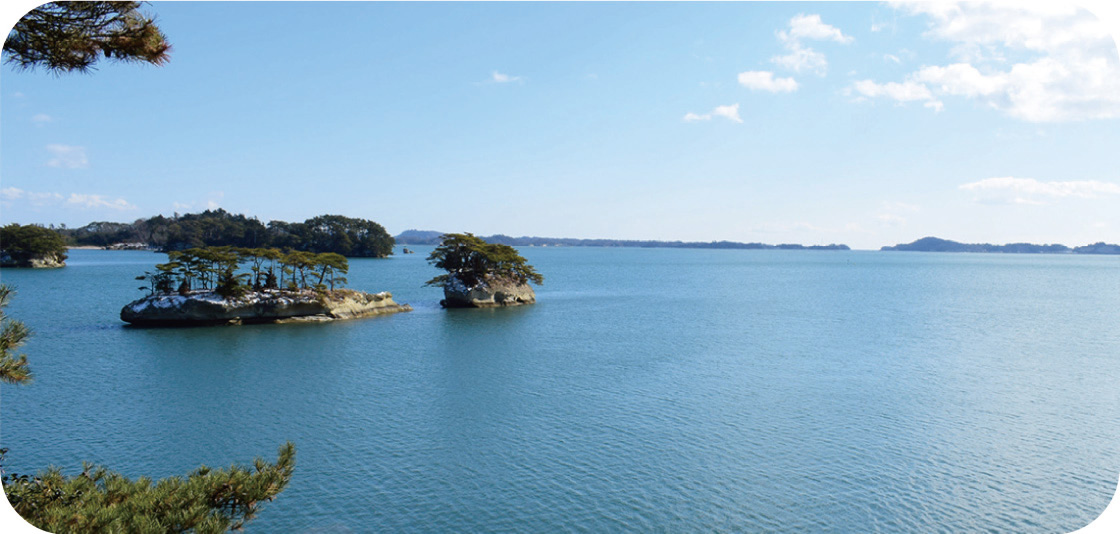Matsushima, one of the Three Views of Japan, is a tourist destination that attracts many visitors every year. There are also cultural properties designated by the national and prefectural governments, many of which were considered representative of “Date Culture Fostered by Masamune,” and were designated as Japan Heritage sites in 2016. Although it has become a major tourist destination, Matsushima, like Koyasan in Wakayama Prefecture and Osorezan in Aomori Prefecture, is a sacred place where the gods and Buddha dwell. In the old days, people believed that places with spectacular scenery such as Matsushima were created by the gods and Buddha, beyond the reach of human power. The emotions and sensations we feel when we see a spectacular view today, along with the awe and trembling in our hearts, remind us of this spiritual power. Many temples and shrines are therefore built on such lands. Jikaku Daishi Ennin built the Tendai sect's Enpukuji Temple in Matsushima in the 5th year of the Tencho Era (828), according to the Tendai Yuishoki passed on to Zuiganji Temple. The temple is considered to have been built not in one place, but rather as several separate halls on the mountain to the northeast of Zuiganji. It is said that Godaido Hall, which Masamune rebuilt, was the one that stood closest to the ocean. Enpukuji was not a very active temple as there were many periods without an abbot in residence.
Around the middle of the 11th century, people began to believe that the teachings of the Buddha had not been transmitted correctly, and that the world had become a disorderly place where no one could be saved. Daily life was hard, people lived on the verge of death and wished to go to the Pure Land of Paradise in their next life. As a result, Matsushima’s scenery, a holy and sacred place, gradually came to be regarded as the scenery of the Pure Land of Paradise. In the first year of the Choji era (1104), a Buddhist priest named Kenbutsu Shonin from Hoki (present-day Tottori Prefecture) came to Matsushima. He built a small temple on Oshima and chanted the Lotus Sutra constantly for 12 years, which is said to have given him horiki power and enabled him to summon the demon gods as he wished. It is also said that he performed many miracles and his fame spread to the Imperial Court. In 1119, Emperor Toba is said to have presented him with a statue of Buddha and a thousand pine trees. This event led to Shonin becoming even more well-known than Enpukuji Temple itself.
In the latter half of the 12th century, the practice of burying ashes of the deceased on Oshima Island began. By burying the ashes on the island where Shonin lived, it was believed that one would be able to go to the Pure Land of Paradise. This action was considered a form of making connection with the Buddha. In the same sense, from the end of the 13th century, the practice of building itabi or stone monuments, which originated in the Kanto region, began on Oshima to memorialize the deceased. These practices started with people of high rank, but gradually spread to ordinary people. Oshima, the most prominent of the sacred places in Matsushima, came to be considered the entrance to the Pure Land of Paradise, thus solidifying Matsushima’s position as a sacred site.
Around the middle of the 13th century, just before the period when itabi began to be built on Oshima, the Rinzai sect’s Enpukuji Temple was built in the precincts of the present Zuiganji Temple with Hoshin Zenji as its abbot. In the past, and based on descriptions from the Tendai Yuihoki, it was believed that the Rinzai Enpukuji Temple had taken over for the Tendai Enpukuji Temple after its demise. However, in recent years, as based on excavations and examinations of literature, it has come to be believed that the Rinzai Enpukuji was built in a newly chosen location and that Tendai Enpukuji, which was thought to have fallen into ruin, continued to exist in diminished capacity.
In the Muromachi period, Rinzai Enpukuji prospered, first as Shozan, and then as a Jissetsu or second-tier temple under the Gozan Jissetsu or Five Mountain System. However, it gradually declined during the Warring States period, and by the end of the 16th century, both its practice and buildings had fallen to disuse.
Date Masamune, who moved from Yonezawa to Iwadeyama as part of a territorial transfer, designated Sendai as the center of his domain and moved to Sendai Castle, which was completed in 1603. The following year, in 1604, he rebuilt Godaido Hall in gratitude for his wish being granted for victory at the Battle of Sekigahara. He then began rebuilding the Rinzai Enpukuji Temple, which had fallen into disrepair. The project took five years and was renamed Zuiganji Temple upon its completion (formally Zuigan Enpuku Zen-ji). With Ungo Zenji as its abbot, Zuiganji became the Date family temple. The story of the temple's history is inscribed on the Matsushima Hojoki plaque that hangs in the main hall of Zuiganji, which states that the temple was built “to pray for the peace and safety of the nation and its people.” For Masamune, who had lived in a world of war when he was young, rebuilding a historic temple in a sacred place was a way for him to demonstrate his piety. In this way, he may have wished to form a spiritual connection with Matsushima to pray for his ancestors’ passing to the Pure Land of Paradise.
The temples Yotokuin, Entsuin, and Tenrinin that stand on both sides of Zuiganji, as well as the approximately 40 halls of various sizes that were all built by the Date family in the mid-Edo period, may have been constructed with similar wishes in mind. Unfortunately, many of them were lost in the early Meiji period. However, keeping in mind the wishes and thoughts of the people of that time, as you walk around Matsushima today, you might notice a different landscape.


